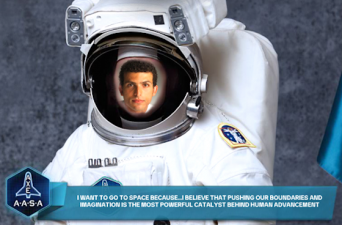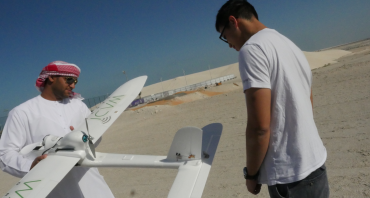
Frequency Electronics makes clocks for time in space. Self-driving cars, drone deliveries, space travel to Mars. Our future depends on a new breed of clocks.
Five..four..three..two..one… a glittered ball drops over Time’s Square in New York City and millions celebrated with kisses, hugs and cheers of Happy New Year! The western 2023 new year was seven hours earlier in Jerusalem, nine hours earlier in Dubai and the last seconds of December 31st 2022 visited Baker and Howland islands in the South Pacific. But even if you missed all of these celebrations you could celebrate according to another calendar. Russian Old New Year (Novy God) begins on January 14th.[/caption]
Chinese year of the water rabbit begins on January 22nd, Islamic Hijri New Year begins at nightfall on July 19th (read this guide on Muslim time), the Mayan New year is on July 26th and Hebrew New Year (Rosh Hashana) 5784 begins at sundown September 15th. With all of these new years to choose from you might ask yourself, what is so special about December 31st? It’s not the shortest day in the year. It’s not when Sirius rises above the great pyramids of Giza or when the Nile floods. It’s not a good time to plant crops. Sunrise and Sunsets are not aligned with Stonehenge. Some years it’s a new moon, other years it’s full or somewhere in between.
One of the first philosophical questions my child asked was, “How did everything get created in only seven days?” Remembering more about physics than religion I fell back on an answer that happened to be among the few where people of science and and people of faith agree. I said, “Time is weird,” but I might just as well have quoted the Book of Kohelet
(Ecclesiastes) 3:11 “He hath made every thing beautiful in his time: also he hath set the world in their heart, so that no man can find out the work that God maketh from the beginning to the end.”
Nature Time
The ancients measured time by observing nature. It made sense to separate the day from the night and further divide these days into times of dawn, sunrise, sunset, dusk and night. Knowing the phases of the moon helped people know the tides and the best times to fish and hunt and knowing the seasons tells us when is a good time to plant and harvest. This is from the first part of the same chapter of Ecclesiastes. Pete Seeger used these words in a folk song made popular by The Byrds:
To every thing there is a season, and a time to every purpose under the heaven:
A time to be born, and a time to die; a time to plant, and a time to pluck up that which is planted;
A time to kill, and a time to heal; a time to break down, and a time to build up;
A time to weep, and a time to laugh; a time to mourn, and a time to dance;
A time to cast away stones, and a time to gather stones together; a time to embrace, and a time to refrain from embracing;
A time to get, and a time to lose; a time to keep, and a time to cast away;
A time to rend, and a time to sew; a time to keep silence, and a time to speak;
A time to love, and a time to hate; a time of war, and a time of peace.
Enter mathematics
About 6000 years ago the Sumerians of southern Iraq invented a sexagesimal (base 60) counting system. Twelve times the number of finger on one hand became the basis for our 24 hour clock, our 60 minute hour and our 60 second minute. Sometime around 3500 B.C.E. the neolithic people of Ireland created mound and stone structures aligned with celestial events but in what may be the world’s oldest sundial, they divided daylight hours into eight sectors and appear to have divided the year into 16 months.
The French attempted to decimalize time in the late 1700s but that went about as well as the U.S attempt to go metric in the 1970s. If the number of heartbeats in a day (86,400+/-), number of days in a lunar month (29.53) and number of lunar months in a year (12.3601) and number of days in a year (365.2425) had been nice round numbers divisible by the number of our fingers and toes, it would have been simple. But it doesn’t and it isn’t. Arguments over how to align human time with natural time have gone on for centuries, dividing religions and inciting wars.
Let’s all agree to disagree
Saint Nicholas of Myra Turkey was among the members of the council of Nicea when it voted to break from the Jewish calendar so that Easter no longer aligned with the passover full moon. The calendar they adopted inherited flaws introduced by Roman emperor Julias Ceasar whose calendar assumed that a year is 365.25 days long. The actual length is about 365.2425 days. The calendar lost about 11 minutes each year until Pope Gregory XIII consulted the Vatican astronomer and left us a simple equation to compensate for the drift and removed 10 days from the calendar of October 1582.
Computer programmers would mistakenly use Julias Ceasar’s flawed leap-year equations for at least 441 years. The colonial United States and majority protestant parts of Europe didn’t accept the new calendar until September 1752 when the “stolen days” triggered riots over lost wages.
The Eastern Orthodox church remained with the Julian calendar. So by 2023 the Orthodox Christmas and New Year arrive about two weeks after the western equivalent.
As the pace of life changed and people journeyed farther into the world they needed to find a way to mimic and improve on natural timekeepers. At the equator, the earth turns at roughly 1000mph (16 miles/second.) So even if a navigator gets a perfect fix on the angle of the sun or star, a 1 second time error could put them 16 miles east or west of where they think they are. In 1714 after the British Navy ran aground on the long Plymouth peninsula one too many times, the British parliament voted to create a reward for anyone who can invent a clock which stayed synchronized with celestial time even in rough seas far from home.
The book Longitude by David Sobel explains this struggle and how the strange custom of dropping a ball helped ships synchronize their clocks with shore time without going ashore. Ships weren’t the only means of transportation which required accurate clocks. Several train accidents and near misses drove people to create a standard railroad time.
Pope Gregory’s calendar bugs
With telescopes made out of stone, it may have taken neolithic builders 500 years to notice errors caused by the slow precession of the earth’s axis but better tools revealed that there are more things in heaven and earth never dreamt of by Pope Gregory XIII. His calendar is also out of step with the heavens. The Earth is not a perfect sphere, its orbit isn’t round, its axis is tilted and wobbles like a top. Our supersize moon moves north and south, nearer and farther in its elliptical orbit. As the moon and sun drag tides across irregular bays and estuaries the friction slows and speeds up the earth’s rotation as the moon, earth and sun orbit moving centers of gravity in a dance with average days growing longer until one day only one hemisphere of the earth will face the moon and life can no longer rely on our familiar patterns of tides.
Atomic time replaces astronomical time
Highly accurate atomic clocks eventually replaced astronomical measurements as a basis for universal standard time. Computers, phones, airline and train schedules take their time from an atomic clock. Since 1972 leap seconds have been occasionally added to keep our standard time aligned with the heavens. Many of us were too distracted with selfies, celebrations and streaming video to notice that the last minute of December 31, 2016 was 61 seconds long.
Unfortunately the software in our devices was designed around 60 second minutes and leap seconds can cause havoc with our technology. To avoid vexing equivalents of Y2K bugs at random intervals, the General Conference on Weights and Measures (CGPM) voted on November 18, 2022 to allow more than 1 second error between universal time (UTC) and astronomical time (UT1.)
What would we do with a better atomic clock?

Navigation and communications rely on precision timing done by an atomic clock
In May of 2022 Frequency Electronics, Inc (NASDAQ: FEIM) announced its next generation of portable Digital Rubidium Atomic Clock (DRAC) suitable for airborn and satellite applications. (Remember, the UAE also plans to build a colony on Mars). Such super accurate clocks can improve existing applications such as drones, self-driving cars and satellite navigation.
It can also be used to make radio communications more immune to interference, for better detection of gravitational waves and possibly in phased array radio telescopes.
Existing global Positioning System (GPS) and Galileo satellite navigation systems rely on cesium atomic clocks which are already precise enough to measure gravitational and velocity time dilation as predicted by Albert Einstein.
The clock on board one of these satellites is slightly slower because it is moving relative to us but slightly faster because gravity makes time run just a little bit slower down here on earth. As Inside Science explains, these relativistic factors balance out to a net gain of 38 microseconds per day. There is nothing wrong with the clock and these errors aren’t caused by complicated astronomical movements.
For these satellites time is actually running 38 microseconds slower per day. You might think we could 38 microseconds of relativistic time dilation but during that 0.000038 seconds, light travels about 7 miles. Time is weird.



